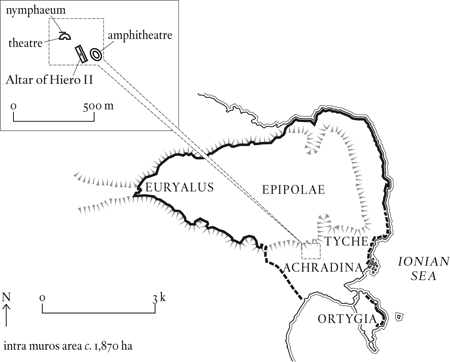
Sicily, Italy
Greek Syrakousai and Roman Siracusa; capital city of the Roman province of Sicily
Just off the south-east coast of Sicily, the island of Ortygia has been occupied since Palaeolithic times. The island was colonized in around 733 BC by Corinthians, and the colony grew to include the adjacent Sicilian mainland. Harbours were developed on both sides of the artificial causeway connecting the two parts of the city.

After relocating or enslaving the nearby native Sicels, the Corinthian colony grew to the point where it founded its own colonies and came into conflict with Carthaginian cities on Sicily, the island that had been founded by Phoenicians. In 480 BC, the tyrant Gelon defeated a Carthaginian force at Himera, establishing Syracuse as a great Mediterranean power. Six years later, Gelon’s brother Hiero I defeated an Etruscan fleet in a battle off CUMAE, further consolidating the city’s power.
During the Peloponnesian War (431–404 BC), Syracuse overcame a massive invasion by the Athenians, a victory celebrated by issuing the famous series of silver decadrachms with Arethusa on the obverse and a four-horse chariot on the reverse. The city extended its influence across more of Sicily under the tyrant Dionysius I (406–367 BC), and its fortifications expanded to an overall length of around twenty-five kilometres (seventeen miles). During its cultural height, Syracuse attracted such distinguished visitors as Pindar and Plato.
Syracusan independence came to an end after the city supported Hannibal in the Second Punic War. In 213–211 BC, the Romans sacked the city after a difficult siege that was reportedly prolonged by the defenders’ use of ingenious weapons devised by Archimedes. This ALEXANDRIA-trained mathematician and engineer had mastered the principles of leverage and devised a grapnel that could hoist the prows of besieging ships until their crews fell out into the sea. He was even said to have used mirrors and/or lenses to focus sunlight and burn enemy ships, although this tale seems to have been highly magnified. As capital of the Roman province of Sicily, Syracuse suffered from the rapacious conduct of the governor Gaius Verres (73–71 BC), who was ultimately disgraced after a public prosecution led by Cicero. Even in that time, however, Cicero affirmed that Syracuse remained ‘the largest of all Greek cities, and the most beautiful of all cities’. Under Augustus, in 21 BC, the city became a Roman colony. St Paul stopped there for three days while en route to ROME, and the city enjoyed prosperity even after it was attacked by Franks in around AD 280.
The tyrant Gelon reportedly constructed the first stone theatre, where the playwright Aeschylus was invited to open the premier season in 476 BC with a production of Women of Aetna. By the time of Hiero (d. 467 or 466 BC), Syracuse could boast a theatre holding around 24,000 spectators. A Roman amphitheatre was added in the first century AD. The city’s importance during early Christian times is reflected in extensive catacombs. After the Roman period, however, the city’s size and importance declined substantially, although the emperor Constans II chose to live there for several years until his assassination in 668.